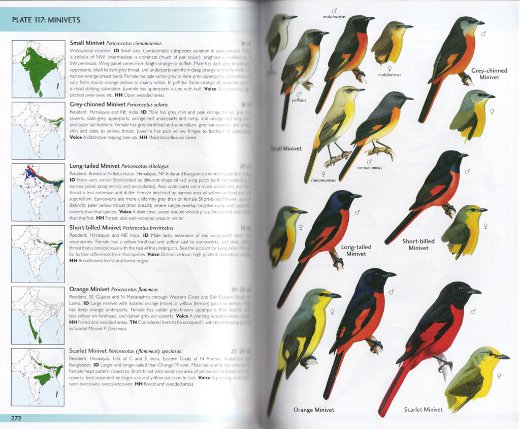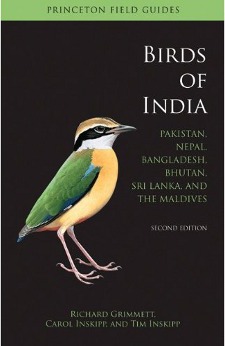Reviewed by Frank Lambert on February 22nd, 2012.
When I first traveled to India at age 19, overland by car from England in the fall of 1978, there were no real field guides to the birds of the subcontinent, so my birding companions and I took everything we could muster, including all ten volumes of Salim Ali’s monumental Handbook of the Birds of India and Pakistan. At that time a lot less was known about the identification of birds in the subcontinent (the bird list comprised about 1200 species), let alone their distributions and taxonomic affinities. We sorely needed a true field guide. Some 34 years later, however, we are spoiled for choice. One of the friends accompanying me on that exciting and enlightening birdathon was Richard Grimmett, one of the three knowledgeable authors of Birds of India: Pakistan, Nepal, Bangladesh, Bhutan, Sri Lanka, and the Maldives. This field guide, the latest to the birds of the vast Indian Subcontinent, covers all species and potential splits known to have occurred up to the end of 2010.
Richard, with Tim and Carol Inskipp, first pooled their vast experience of Indian birds to produce a handbook, the Birds of the Indian Subcontinent (Helm Identification Guide), in November 1988. This was followed by various spin-off regional field guides, such as Birds of Nepal (2000), Birds of Northern India
(2004), Birds of Southern India
(2005), and most recently Birds of Sri Lanka (2012). The first pocket guide to the Birds of India: Pakistan, Nepal, Bangladesh, Bhutan, Sri Lanka, and the Maldives (published in UK as Birds of the Indian Subcontinent by Helm Field Guides) was published in 1999. This guide is now well out of date, and has been fully updated in this excellent, vastly improved second edition. This new edition is now the best book available for the job, being more up-to-date taxonomically than all the competing guides except Birds of South Asia: The Ripley Guide (Rasmussen and Anderton 2005, Lynx Editions), which is sadly out of print (Ed. – although it appears a new edition is forthcoming).
Even if you have the first edition of the Birds of India: Pakistan, Nepal, Bangladesh, Bhutan, Sri Lanka, and the Maldives, you will benefit enormously from this second edition if you intend to bird anywhere in the Indian Subcontinent. This new edition covers an incredible 1,375 species (including all known vagrants). These are illustrated on 226 color plates that show many distinct plumages and races. Since the first edition, 73 new plates have been added and most existing plates have been revised, whilst the text and distribution maps are now found opposite the illustrations – something that was sometimes lacking in the first edition. The text has also been extensively revised, and all the detailed range maps have been completely redrawn to reflect present knowledge. Alternative English bird names are provided where appropriate. More importantly, many new species have been added based on recent taxonomic changes and discoveries made by birders visiting the region.

Plate and species account layout (sorry for the poor quality of the scan, the real thing looks much better)
The text, as one would expect, describes the bird and its status, voice, and habitat. The distribution maps are color-coded for resident, summer visitor, winter visitor, migratory visitor, and “known to be occasional, scarce or erratic”. Small, isolated populations and former ranges are also included where appropriate. The book also has much useful information in the introduction, including sections about the climate, the main habitats, bird conservation in the region, and summaries of the various bird families covered by the guide which will greatly benefit newcomers to the region. There is also a glossary with explanations of terminology used in describing birds, and a color map of the region that shows the States and Provinces, major rivers, mountain ranges, and other geographic features of significance to the birder.
The increase in the number of species covered in this volume is primarily a result of taxonomic changes. Many of these result from the diligent, ground-breaking efforts of Pam Rasmussen, who proposed many splits in her fantastic Birds of South Asia: The Ripley Guide in 2005. At the time this was a hugely controversial and often criticized approach, even though the basis for her splits were for the most part very carefully researched and justified in the text. Now Pam has been largely vindicated, and the majority of her proposed splits are now accepted by the ornithological community or seem likely to be so in the future. In this second edition of the Birds of India the authors have adopted many of the splits that first appeared in Birds of South Asia.
In addition, there are a further 91 taxa that have full species accounts and illustrations despite the fact that the authors consider the evidence for the splits to be inadequate – although it is worth noting that IOC has already now accepted many of these. Indeed, IOC (v2.10) has given full species status to some taxa for which this book says “research has failed to support their split” – such as Afghan Babbler Turdoides huttoni and Malabar (Blyth’s) Starling Sturnia blythii. Nevertheless, since this field guide still has a species account, map, and illustrations for all 91 taxa of questionable taxonomic status, one can still identify them in the field. A very useful and detailed section at the very beginning of the book identifies those splits that have been accepted and those that the authors consider still require confirmation.
Overall, Birds of India: Pakistan, Nepal, Bangladesh, Bhutan, Sri Lanka, and the Maldives is an excellent piece of work and a very welcome field guide, and I am greatly looking forward to using it on my upcoming trip to Arunachal Pradesh and Assam. Comprehensive and authoritative, this is an indispensable guide for anyone birding anywhere in the Indian Subcontinent.
– Reviewed by Frank Lambert
This book has been co-published by Princeton University Press in the U.S. and Christopher Helm in the UK.
Disclosure: I get a small commission for purchases made through links in this post.





 (6 votes, average: 4.67 out of 5)
(6 votes, average: 4.67 out of 5)
nice
[…] Birds of the Indian Subcontinent […]
[…] Birds of the Indian Subcontinent […]